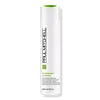What's inside
What's inside
 Key Ingredients
Key Ingredients

 Benefits
Benefits

 Concerns
Concerns

 Ingredients Side-by-side
Ingredients Side-by-side

Water
Skin ConditioningCetyl Alcohol
EmollientCetearyl Alcohol
EmollientQuaternium-91
Cetrimonium Methosulfate
AntimicrobialAmodimethicone
Cetyl Esters
EmollientAlgae Extract
EmollientAloe Barbadensis Extract
Skin ConditioningAnthemis Nobilis Flower Extract
MaskingRosmarinus Officinalis Leaf
Skin ConditioningSimmondsia Chinensis Seed Oil
EmollientHydrolyzed Wheat Protein Pg-Propyl Silanetriol
Skin ConditioningAcetic Acid
BufferingAlcohol
AntimicrobialBisamino PEG/PPG-41/3 Aminoethyl Pg-Propyl Dimethicone
C11-15 Pareth-7
EmulsifyingC12-16 Pareth-9
EmulsifyingCetrimonium Chloride
AntimicrobialCitric Acid
BufferingDimethicone
EmollientGlycerin
HumectantGuar Hydroxypropyltrimonium Chloride
Skin ConditioningMagnesium Chloride
Magnesium Nitrate
Olealkonium Chloride
PEG-12 Dimethicone
Skin ConditioningPolyquaternium-37
Polysorbate 60
EmulsifyingPPG-1 Trideceth-6
Skin ConditioningPropylene Glycol Dicaprylate/Dicaprate
EmollientTetrasodium EDTA
Tribehenin
EmollientTrideceth-12
EmulsifyingTrideceth-15
EmulsifyingTrideceth-3
EmulsifyingTriethyl Citrate
MaskingTrimethylsiloxyamodimethicone
Methylchloroisothiazolinone
PreservativeMethylisothiazolinone
PreservativePhenoxyethanol
PreservativeParfum
MaskingHexyl Cinnamal
PerfumingLinalool
PerfumingWater, Cetyl Alcohol, Cetearyl Alcohol, Quaternium-91, Cetrimonium Methosulfate, Amodimethicone, Cetyl Esters, Algae Extract, Aloe Barbadensis Extract, Anthemis Nobilis Flower Extract, Rosmarinus Officinalis Leaf, Simmondsia Chinensis Seed Oil, Hydrolyzed Wheat Protein Pg-Propyl Silanetriol, Acetic Acid, Alcohol, Bisamino PEG/PPG-41/3 Aminoethyl Pg-Propyl Dimethicone, C11-15 Pareth-7, C12-16 Pareth-9, Cetrimonium Chloride, Citric Acid, Dimethicone, Glycerin, Guar Hydroxypropyltrimonium Chloride, Magnesium Chloride, Magnesium Nitrate, Olealkonium Chloride, PEG-12 Dimethicone, Polyquaternium-37, Polysorbate 60, PPG-1 Trideceth-6, Propylene Glycol Dicaprylate/Dicaprate, Tetrasodium EDTA, Tribehenin, Trideceth-12, Trideceth-15, Trideceth-3, Triethyl Citrate, Trimethylsiloxyamodimethicone, Methylchloroisothiazolinone, Methylisothiazolinone, Phenoxyethanol, Parfum, Hexyl Cinnamal, Linalool
Water
Skin ConditioningDipropylene Glycol
HumectantPolysilicone-29
Silicone Quaternium-18
EmollientArgania Spinosa Kernel Oil
EmollientArtocarpus Heterophyllus Fruit Extract
Skin ConditioningAmaranthus Caudatus Seed Extract
Skin ConditioningParfum
MaskingPolysorbate 20
EmulsifyingTrideceth-12
EmulsifyingMethylpropanediol
SolventTrideceth-6
EmulsifyingCaprylyl Glycol
EmollientGlycolic Acid
BufferingPolyquaternium-80
CleansingCitric Acid
BufferingC12-13 Pareth-9
EmulsifyingHydrolyzed Quinoa
Skin ConditioningSodium PCA
HumectantSodium Lactate
BufferingDidecyldimonium Chloride
EmulsifyingArginine
MaskingAspartic Acid
MaskingPotassium Hydroxide
BufferingPCA
HumectantLactobacillus Ferment
Skin ConditioningGlycine
BufferingAlanine
MaskingAlgin
MaskingCaprylic/Capric Triglyceride
MaskingChitosan
Serine
MaskingValine
MaskingIsoleucine
Skin ConditioningProline
Skin ConditioningThreonine
Histidine
HumectantPhenylalanine
MaskingPhenoxyethanol
PreservativeSodium Benzoate
MaskingPotassium Sorbate
PreservativeBenzyl Alcohol
PerfumingLinalool
PerfumingAlpha-Isomethyl Ionone
PerfumingWater, Dipropylene Glycol, Polysilicone-29, Silicone Quaternium-18, Argania Spinosa Kernel Oil, Artocarpus Heterophyllus Fruit Extract, Amaranthus Caudatus Seed Extract, Parfum, Polysorbate 20, Trideceth-12, Methylpropanediol, Trideceth-6, Caprylyl Glycol, Glycolic Acid, Polyquaternium-80, Citric Acid, C12-13 Pareth-9, Hydrolyzed Quinoa, Sodium PCA, Sodium Lactate, Didecyldimonium Chloride, Arginine, Aspartic Acid, Potassium Hydroxide, PCA, Lactobacillus Ferment, Glycine, Alanine, Algin, Caprylic/Capric Triglyceride, Chitosan, Serine, Valine, Isoleucine, Proline, Threonine, Histidine, Phenylalanine, Phenoxyethanol, Sodium Benzoate, Potassium Sorbate, Benzyl Alcohol, Linalool, Alpha-Isomethyl Ionone
Ingredients Explained
These ingredients are found in both products.
Ingredients higher up in an ingredient list are typically present in a larger amount.
Citric Acid is an alpha hydroxy acid (AHA) naturally found in citrus fruits like oranges, lemons, and limes.
Like other AHAs, citric acid can exfoliate skin by breaking down the bonds that hold dead skin cells together. This helps reveal smoother and brighter skin underneath.
However, this exfoliating effect only happens at high concentrations (20%) which can be hard to find in cosmetic products.
Due to this, citric acid is usually included in small amounts as a pH adjuster. This helps keep products slightly more acidic and compatible with skin's natural pH.
In skincare formulas, citric acid can:
While it can provide some skin benefits, research shows lactic acid and glycolic acid are generally more effective and less irritating exfoliants.
Most citric acid used in skincare today is made by fermenting sugars (usually from molasses). This synthetic version is identical to the natural citrus form but easier to stabilize and use in formulations.
Read more about some other popular AHA's here:
Learn more about Citric AcidLinalool is a fragrance and helps add scent to products. It's derived from common plants such as cinnamon, mint, citrus, and lavender.
Like Limonene, this ingredient oxidizes when exposed to air. Oxidized linalool can cause allergies and skin sensitivity.
This ingredient has a scent that is floral, spicy tropical, and citrus-like.
Learn more about LinaloolParfum is a catch-all term for an ingredient or more that is used to give a scent to products.
Also called "fragrance", this ingredient can be a blend of hundreds of chemicals or plant oils. This means every product with "fragrance" or "parfum" in the ingredients list is a different mixture.
For instance, Habanolide is a proprietary trade name for a specific aroma chemical. When used as a fragrance ingredient in cosmetics, most aroma chemicals fall under the broad labeling category of “FRAGRANCE” or “PARFUM” according to EU and US regulations.
The term 'parfum' or 'fragrance' is not regulated in many countries. In many cases, it is up to the brand to define this term.
For instance, many brands choose to label themselves as "fragrance-free" because they are not using synthetic fragrances. However, their products may still contain ingredients such as essential oils that are considered a fragrance by INCI standards.
One example is Calendula flower extract. Calendula is an essential oil that still imparts a scent or 'fragrance'.
Depending on the blend, the ingredients in the mixture can cause allergies and sensitivities on the skin. Some ingredients that are known EU allergens include linalool and citronellol.
Parfum can also be used to mask or cover an unpleasant scent.
The bottom line is: not all fragrances/parfum/ingredients are created equally. If you are worried about fragrances, we recommend taking a closer look at an ingredient. And of course, we always recommend speaking with a professional.
Learn more about ParfumPhenoxyethanol is a preservative that has germicide, antimicrobial, and aromatic properties. Studies show that phenoxyethanol can prevent microbial growth. By itself, it has a scent that is similar to that of a rose.
It's often used in formulations along with Caprylyl Glycol to preserve the shelf life of products.
We don't have a description for Trideceth-12 yet.
Water. It's the most common cosmetic ingredient of all. You'll usually see it at the top of ingredient lists, meaning that it makes up the largest part of the product.
So why is it so popular? Water most often acts as a solvent - this means that it helps dissolve other ingredients into the formulation.
You'll also recognize water as that liquid we all need to stay alive. If you see this, drink a glass of water. Stay hydrated!
Learn more about Water